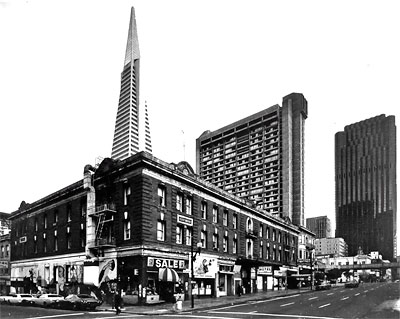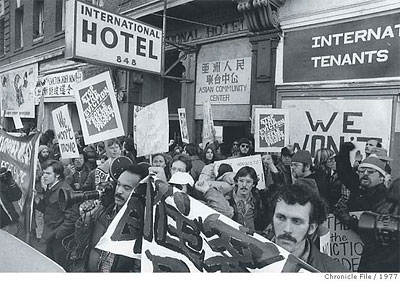National Register of Historic Places in San Francisco
International Hotel
848 Kearny Street Between Washington and Jackson
Built 1873
Rebuilt 1907
Demolished 1977
Rebuilt 2003-2005
The original International Hotel, intended as a luxury destination for wealthy travelers, was built on Jackson Street in 1854, moved to its 848 Kearny Street location in 1873 and was rebuilt in 1907 after the great San Francisco earthquake and fire in 1906. By the 1920s, the International Hotel, known locally as the I-Hotel, found itself squarely in the middle of a 10-block Filipino American enclave along Kearny Street known as Manilatown, the first Filipino American community in San Francisco, and one of the first (and few) across the country.
By 1968, the I-Hotel's tenants were predominantly aging first-generation laborers referred to as manongs (a respectful Filipino term for elder brother or uncle) who, as victims of exclusive anti-Asian immigration laws, had been forced to live isolated bachelor lives. Many were also U.S. war veterans. Most, by virtue of U.S. colonial occupation of the Philippines from the turn of the 20th century until 1946, were American nationals.
Source: Terry Hong, San Francisco Chronicle, 19 August 2007

From 1920-35 there was a Filipino male population of 39,328. Legislation forbid Filipinos from owning land or setting up businesses. They were to be kept moving, remain transient. They stayed in labor camps, rooming houses and hotels.
The International Hotel was one of these. Manilatown, the Kearny/Jackson Street area of San Francisco, became a permanent settlement, a convenient culture contact. It was the home field-workers returned to, where merchant marines lived while in port, where distant relatives and friends could be contacted, where they could enjoy the security of a common culture.
Immigration laws re-enforced the role the International Hotel played as a family with the social protection it provided. The Filipino community in San Francisco existed in groups dictated by economic necessity and blood brotherhood. The International Hotel became a symbol for an entire minority community.
About 1954, the International Hotel became significant for yet another reason. Enrico Banduccci, opened his original "hungry i" (hungry intelectual) nightclub next door to Club Mandalay in the basement of the International Hotel where performing artists got their start, such as: Nina Simone, the Smothers Brothers, Lenny Bruce, the Kingston Trio, "Professor" Irwin Corey and Bill Cosby, to name a few.
In 1977, the tenants of the International Hotel, mostly elderly Filipinos, were evicted. Subsequently, because of strong community opposition, the site was designated by the Board of Supervisors as a site for low income senior housing.
Quoted from ManilaTown Heritage Foundation website.

